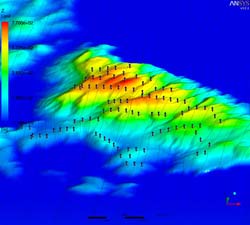Computer Model Optimizes Wind Farm

When the wind causes the huge rotors to turn, it generates turbulence, which interferes with the operation of the wind turbines in the rows to the rear. To address this problem, the new software program simulates the behavior of the entire wind farm and adjusts the individual turbines’ performance with one another.
According to experts, this could increase the energy yield by several percent, as reported in the latest issue of the research magazine “Pictures of the Future”. The same method could also be used to reduce the mechanical stress on the wind turbines, thus extending their service life. The software is currently undergoing endurance testing at Sweden’s Lillgrund wind farm.
Offshore wind turbines are gigantic; the 48 Siemens turbines in Lillgrund tower 115 meters above the water’s surface. The rotors have a diameter of 93 meters, and the wind causes them to create kilometer-long trails of turbulence. As a result, turbines located behind the first row can’t operate smoothly, causing their electricity output to fluctuate. In addition, the turbulence makes the turbines vibrate, which accelerates the process of wear and tear. A wind turbine is designed to operate for about 20 years. If it can run longer than that, the wind farm can supply more energy without requiring any additional investment.
Researchers at Siemens Corporate Technology have now developed a computer model that simulates entire wind farms. Using measurements of wind and rotor speeds, temperature, and turbine output, the software calculates airflows and determines the behavior of all of the turbines, enabling it to set the parameters for operating the wind turbines with as little turbulence as possible. The turbines’ output is adjusted by means of the generators and the angle of the rotor blades. To make this possible, all of the turbines are connected to a central control system via optical fiber lines. Even though the system reduces the output of individual wind turbines, it increases the yield of the wind farm as a whole and ensures that turbines located farther back are subjected to less strain. Operators can use the program to optimize either the energy yield or the service life. Alternatively, they can use it to optimally balance both of these parameters with each other.
Siemens Wind Power has been testing the software in Lillgrund for the past two years. In the fall the model will be optimized on the basis of the collected measurement data, to be followed by a pilot phase. Offshore wind farms are part of Siemens’ environmental portfolio, with which the company generated about €28 billion in sales in fiscal year 2010.
Media Contact
More Information:
http://www.siemens.com/researchnewsAll latest news from the category: Power and Electrical Engineering
This topic covers issues related to energy generation, conversion, transportation and consumption and how the industry is addressing the challenge of energy efficiency in general.
innovations-report provides in-depth and informative reports and articles on subjects ranging from wind energy, fuel cell technology, solar energy, geothermal energy, petroleum, gas, nuclear engineering, alternative energy and energy efficiency to fusion, hydrogen and superconductor technologies.
Newest articles

Superradiant atoms could push the boundaries of how precisely time can be measured
Superradiant atoms can help us measure time more precisely than ever. In a new study, researchers from the University of Copenhagen present a new method for measuring the time interval,…

Ion thermoelectric conversion devices for near room temperature
The electrode sheet of the thermoelectric device consists of ionic hydrogel, which is sandwiched between the electrodes to form, and the Prussian blue on the electrode undergoes a redox reaction…

Zap Energy achieves 37-million-degree temperatures in a compact device
New publication reports record electron temperatures for a small-scale, sheared-flow-stabilized Z-pinch fusion device. In the nine decades since humans first produced fusion reactions, only a few fusion technologies have demonstrated…





















